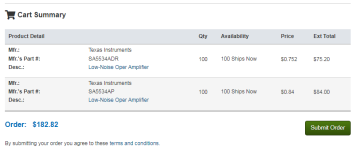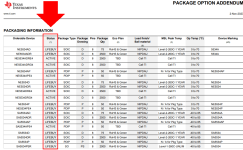Manufacturing end of production, or distribution/retail EOL? TI, Signetics, who else produced it all stopped producing?
NE5532A (dual) is still active.
NE5532A has worse noise specifications than NE5534A (and it is compensated for unity gain rather than a gain of three).
NE5534 without the A is apparently also end of life.
Did anyone check if JRC still makes them?
Those are reputedly better quality than TI.
Onsemi also last shipments, if you need to know...
Amazon India is saying 'generic' for chips with TI logo...so that source is there.
And the TI TL074/084 should be available, with better specs for slew rate. I think that can still be used for new builds.
Those are reputedly better quality than TI.
Onsemi also last shipments, if you need to know...
Amazon India is saying 'generic' for chips with TI logo...so that source is there.
And the TI TL074/084 should be available, with better specs for slew rate. I think that can still be used for new builds.
TI now tries to sell CMOS op-amps with awful 1/f noise as if they were TL07x's. In any case, a TL071 is not a good alternative for an NE5534 if you need the low voltage noise or the load driving abilities.
OPA1642 ad OPA1652 are JFET devices with reasonably low voltage noise and low distortion - the 1652 however cannot drive 600 ohms well.
The LM4562 of course has 12dB more current noise than the NE5534A and the issues with high susceptibility to RFI, no production testing for noise (with large variation by all accounts).
The LM4562 of course has 12dB more current noise than the NE5534A and the issues with high susceptibility to RFI, no production testing for noise (with large variation by all accounts).
Last edited:
This is probably happening because the sales and or profitability have dropped right off. You can still make a pretty decent phono amp with a OPA1641/2.
A shipping carton of those would be in the region of 50,000 pieces, how many of us can buy that quantity?
The market has gone digital, and hi fi is not the main target now, it is portable devices.
My advice: stock up, and check out the alternates as well, they will also go out of production without factory level orders.
See if any useful products are found in industrial equipment, that tends to have longer life cycles. Use those for new builds.
And some devices now have sufficient output to drive the main amps, no need for a pre-amp at all...
The market has gone digital, and hi fi is not the main target now, it is portable devices.
My advice: stock up, and check out the alternates as well, they will also go out of production without factory level orders.
See if any useful products are found in industrial equipment, that tends to have longer life cycles. Use those for new builds.
And some devices now have sufficient output to drive the main amps, no need for a pre-amp at all...
Last edited:
They now are not so awful ! : OPA192 has 5.5 nV/sqrtHz @ 1 kHz and 10 nV @ 100 Hz, almost 1641 . And THD 0.00008% and 5 microV offset (vs 1 mV of 1641). Input current noise 1.5 fA/sqrtHz @ 1 kHz (vs 0.4 pA of 5534). For MM phono is much better than 5534, 210, 1641, imho. PS. Output short circuit current 65 mA vs 38 mA of 5534.TI now tries to sell CMOS op-amps with awful 1/f noise as if they were TL07x's.
Last edited:
Those are not the ones they try to sell as if they were TL071...TL074. I meant the TL07xH series and its derivatives.
It was a great chip at its time. Personally I dropped this one for decades because
-I preferred since the early days dual op-amps
-hi current consumption
-hi input noise current
-differential input clamped
-not recommended for low operating voltage.
My bread and butter op-amps nowadays are OPA1678 and OPA2991.
And no, I do not design phono pre-amps😉
-I preferred since the early days dual op-amps
-hi current consumption
-hi input noise current
-differential input clamped
-not recommended for low operating voltage.
My bread and butter op-amps nowadays are OPA1678 and OPA2991.
And no, I do not design phono pre-amps😉
Because of the noise shaping by the RIAA EQ amplifier, you can do slightly better with an OPA1641/2 than a NE5534A and you get better RFI to boot. The SNR figures below are the absolute best case for a standard RIAA EQ amp with a cart of 1000 Ohms and 500 mH, 47k load and 125pF input capacitance (c 1.5-2m interconnect cable from T/T to phono amp). The gain setting resistor for these results was set at 110 Ohms (which is what the X-Altra MC/MM used but with paralleled LSK389/JFE2140 devices for the MM stage).
Of course, the OPA164x devices are a lot more expensive.
Data below from the Hifisonix RIAA noise calculator you can find here https://hifisonix.com/preamplifiers/so-just-how-quiet-is-your-phono-stage/

Of course, the OPA164x devices are a lot more expensive.
Data below from the Hifisonix RIAA noise calculator you can find here https://hifisonix.com/preamplifiers/so-just-how-quiet-is-your-phono-stage/
- Home
- Source & Line
- Analog Line Level
- NE5534A end of life announced


